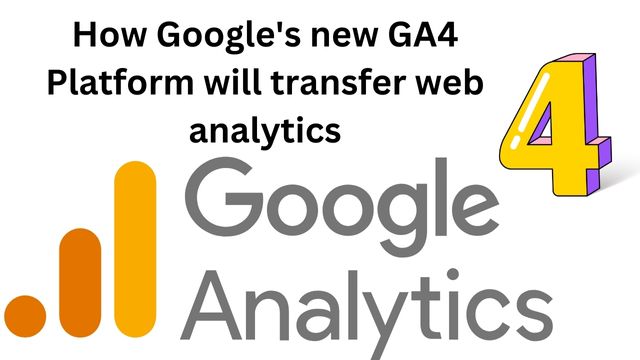Google Analytics 4: How Google’s new GA4 Platform will transfer web analytics

Have you switched over to the Google Analytics 4 platform from Google’s previous platform, Universal Analytics? In that case, why not?
There are numerous reasons to finish the move right now. On July 1st, 2023, Google will stop supporting its market-dominating Universal Analytics version.
However, GA4 is a very different system, so it will take some time for marketers to become used to the new user interface and data collection techniques.
Furthermore, Google claims that after the sunset date, data gathered by Universal Analytics will only be available for a minimum of six months.
The more data that becomes accessible for historical comparison once Google Analytics 4 becomes the only choice, the earlier GA4 starts recording data.
The most recent in a series of significant news events that have continued to alter web analytics and the overall landscape of digital marketing is Google’s transition to GA4.
Many of the changes are being driven by the fight for stronger consumer data privacy protection, which is the topic of DAC’s recent white paper in Ad Age, “The Marketer’s Guide to Web Analytics in a Privacy-First World.”
What is GA4?
To begin with, Google Analytics, which offers a variety of tools to assist businesses learn more about website traffic, was introduced back in 2005.
Anything with a distinct tracking ID can be tracked by Google Analytics, including websites, mobile apps, and blogs. “Property” refers to anything you are keeping an eye on.
Without a doubt, Google Analytics is the most popular traffic analysis tool on the planet.
According to research, Google Analytics is used by 55% of all websites.
That alone may sound remarkable, but when you consider that more than one-third of websites do not utilise any tracking tools at all, you begin to appreciate just how enormous Google Analytics’ market share really is.
Because Google dominates so many aspects of the internet, any change it announces is sure to cause a stir. And the switch to Google Analytics’ fourth edition is also no exception.
How Google’s new GA4 Platform will transfer web analytics
- A GA4 primer: button, text, color, URL
- Better tracking of user behaviour
- Strategies to future-proof the organisation
A GA4 primer: button, text, color, URL
The tracking of events was restricted to three fundamental criteria in Google’s prior system: category, action, and label. Marketers may go much more deeply into the descriptive actions that take place within a specific session using GA4.
Whether a user visits a page, clicks a button, or watches a video, any action you wish to measure may be considered an event, according to Mario Lyn, manager of web analytics at DAC’s Prove Intelligence.
While GA4 can attribute numerous characteristics to the same action, such as button wording, colour, page URL, and more, Universal Analytics defines conversions around a single action, such as pressing a button. This data would be carefully analyzed to show which button click variables worked the best.
When you display the screen with Universal Analytics, everyone sees the same kind of data, according to Lyn. “However, GA4 allows you to add more features and layers to each individual piece of data. Therefore, you need to think much more carefully about what and how you’re gathering.
Better tracking of user behaviour
The new features in GA4 have the potential to greatly enhance the marketer’s capacity for data collection and analysis.
Due to the loss of third party data, such as cookies from Google’s Chrome browser and unique identifiers from significant mobile advertising platforms, GA4 can assist marketers in filling the hole.
GA4’s event-based platform enables advertisers to follow user behaviour with up to 50 different characteristics, in contrast to Universal Analytics’ session-based model, which primarily analyses website hits and page views.
With this, a considerably more thorough picture of a customer’s web interactions, including the phases leading up to a conversion or sale, should be made available.
In addition, GA4’s new e-commerce tools, enhanced Google Ads integration, and capability to link web traffic with mobile app data all provide a more comprehensive picture of the entire customer experience.
If you want to use Adobe Analytics you can check out How to use Adobe Analytics features for data analysis & personalization
Strategies to future-proof the organization
With GA4, marketers will have more power over their data and entire web analytics strategy, as well as more chances to do so.
The decline in third-party data has forced today’s marketers to “backfill the gap in intelligence and fidelity,” according to Dan Temby, senior VP, technology and analytics, at DAC Group.
He said that in contrast to a collection of discrete platforms created to perform different tasks, “all of the changes we’re seeing as a result of privacy regulation are forcing people along the path of a really integrated marketing technology stack.”
According to Temby, Web analytics has always been separate from advertising-related tasks like demand-side platforms and data management platforms. “At this time, everyone is discussing the necessity for an integrated set of signals to be compared to an integrated consumer profile.
The cornerstone of that capability, web analytics, is a linked martech stack, which is the only way to accomplish that.
Organizations have various tools at their disposal to get ready for future privacy-related changes. For instance, they can develop stronger data partnerships with publishers, who have access to visitor demographic and behavioral data that marketers might not have.
Additionally, they can collaborate more closely with their own data scientists and engineers on new statistical methods for budgeting choices and ROI estimates in a dynamic digital media environment.
Last but not least, marketers must concentrate on factors under their direct control. Solutions for cookie-free advertising will ebb and flow (remember FLOC?). Attempting to predict the next big thing isn’t always a good idea. It might not be as huge by the time you do.
In the end, marketers will always find a way to communicate with those who are interested in their products. As future-proof as marketing can be is to first understand who those consumers are, regardless of medium.
What’s the impact of the transition to GA4?
- UA data cannot be merged into GA4
- Sunsetting and removal of UA
- Changes to the interface and pre-built reports
UA data cannot be merged into GA4
Unfortunately, as of the date of this article’s publication, none of the data from your current UA account, including all traffic and customizations, will be transferrable to your new account.
It’s safer to operate with the idea that no data or customised settings will automatically move, even though it’s likely that this may change or that there may eventually be some exceptions.
Google Analytics data will only be accessible through GA4 as of October 1, 2023.
Additionally, the data you have access to in GA4 will only go back as far as the time that your GA4 account was initially set up.
Therefore, if you set up your GA4 account on June 14, 2022, your first full day of data in GA4 is probably not going to be available until about June 16, 2022. And on June 16, 2022, Google Analytics will begin collecting data from your site when UA data becomes unreachable on October 1, 2023.
You are allowed to download your previous UA data up until October 1, 2023. You won’t likely be able to export everything you might require. Even if you could, there would be too much information.
Decide which reports will be most useful to have on hand by carefully considering the data that is utilised most frequently, pertinent time frames, various daily, weekly, and monthly splits, segments, etc. In order to export UA data in a form that will be useful in the future, consider the historical data you’ll want to review in a month, a quarter, or a year from now.
Sunsetting and removal of UA
The current iteration of Google’s analytics technology, known as Universal Analytics, will be retired (UA). It will eventually cease to exist for Google users, along with the information you have collected with it.
On July 1st, 2023, your UA properties will stop collecting new data. You will initially have access to site data gathered up through June 30, 2023, for a further six months. But following that, Google will stop making UA site data available.
(Take note that starting on October 1, 2023, Google’s 360 Universal Analytics will no longer be collecting new data.)
Changes to the interface and pre-built reports
The platform’s reporting capabilities will differ since GA4 uses a different method of data collection and offers a number of new services.
The numerous reports you now use probably have a different format. Google may have occasionally moved or changed reports or report settings. Other times, the Google Analytics 4 property might not have any characteristics that are comparable.
The plus side is that new customization tools enable you to duplicate some of the familiar UA reports and build original reports from scratch.
The Benefits of Google Analytics 4
- A more complete picture of your full customer life cycle will be shown by GA4. It won’t be necessary for you to rely on paid cross-channel attribution.
- Data between the app and website will be connected using GA4.
- Even if you have gaps in your data, you can still track user data with or without identifiers or cookies (which is excellent because third-party cookies will soon be phased away).
- Since it won’t rely on cookies like Universal Analytics, you’ll be able to get more accurate and precise data.
- It helps you more accurately identify audiences that have a greater likelihood of converting because it is AI-driven.
- As you analyse consumer interactions with your paid advertising, you’ll be able to assess the value of each ad click thanks to new data attribution.
Conclusion
The most widely used traffic analysis tool on the planet is Google Analytics. In 2023, Google will stop providing support for its market-leading Universal Analytics version. It will take some time for marketers to get acclimated to the new user interface because GA4 is a totally different technology. In contrast to Universal Analytics’ session-based architecture, GA4’s event-based technology allows advertisers to track user behaviour with up to 50 different variables.
The expanded Google Ads connection, e-commerce facilities, and ability to integrate web traffic with mobile app statistics offered by GA4 all contribute to a more complete understanding of the full consumer experience. Marketers may prepare for upcoming privacy-related changes using a variety of technologies. As on October 1, 2023, Google Analytics data will only be available through GA4.






